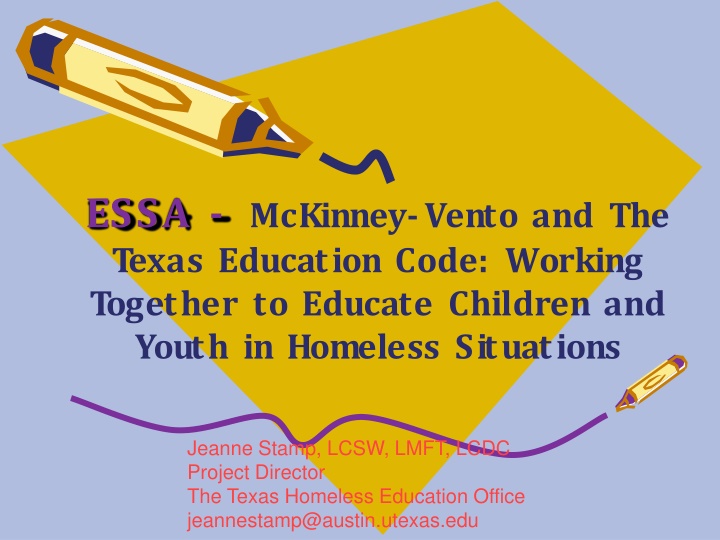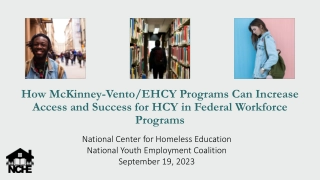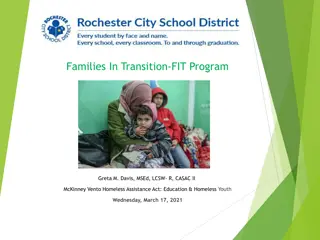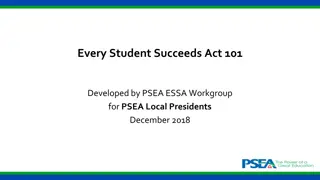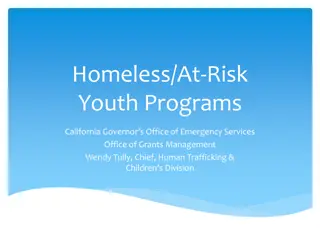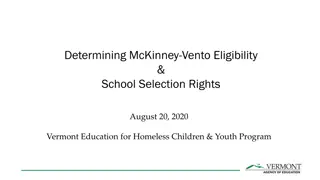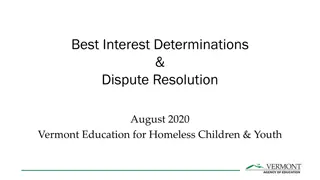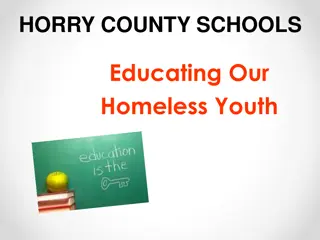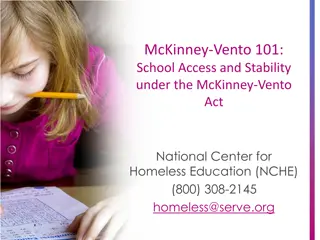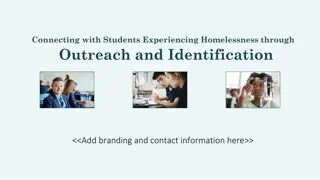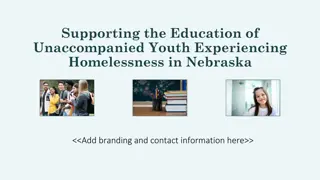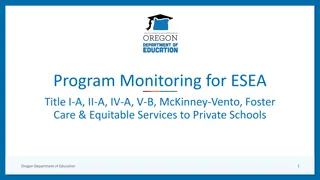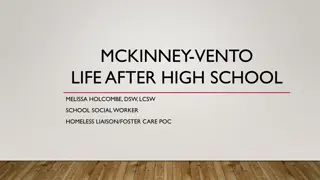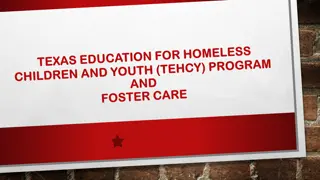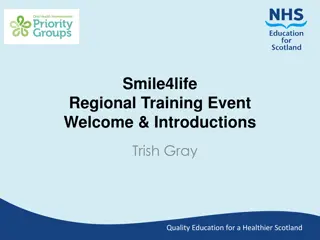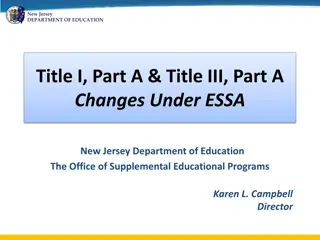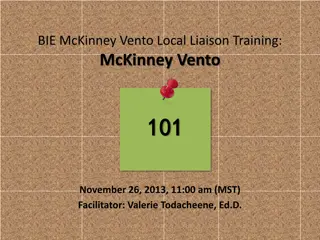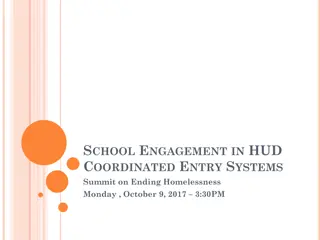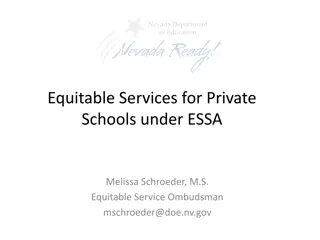ESSA & McKinney-Vento in Texas: Educating Children & Youth in Homeless Situations
Collaborating under ESSA, the McKinney-Vento Act supports homeless students in Texas. The data reveals widespread challenges. Key themes impacted by ESSA include identification, school stability, enrollment, and academic success support.
Uploaded on Mar 05, 2025 | 0 Views
Download Presentation

Please find below an Image/Link to download the presentation.
The content on the website is provided AS IS for your information and personal use only. It may not be sold, licensed, or shared on other websites without obtaining consent from the author.If you encounter any issues during the download, it is possible that the publisher has removed the file from their server.
You are allowed to download the files provided on this website for personal or commercial use, subject to the condition that they are used lawfully. All files are the property of their respective owners.
The content on the website is provided AS IS for your information and personal use only. It may not be sold, licensed, or shared on other websites without obtaining consent from the author.
E N D
Presentation Transcript
ESSA - McKinney-Vento and The Texas Education Code: Working Together to Educate Children and Youth in Homeless Situations Jeanne Stamp, LCSW, LMFT, LCDC Project Director The Texas Homeless Education Office jeannestamp@austin.utexas.edu
Tracking Training: Sign-in Please http://www.region10.org/mvhpd/ 2
Welcome http://www.region10.org/mvhpd The following screen will display: Slide 3
McKinney-Vento Homeless Assistance Act Originally passed in 1987. Reauthorized in 2015 by the Every Student Succeeds Act (ESSA 10/1/2016). Works hand-in-hand with Title IA and other federal education programs. $85 million authorized funding to SEAs. Largest percentage increase of all federal education programs. SEAs award competitive subgrants to LEAs. 4
Texas Data Total students enrollment in public schools: 5,232,065 Total students economically disadvantaged: 3,068,820 Rate economically disadvantaged students: 58.8% (per TEA) Total homeless students enrolled: 113,294
More students experience homelessness in Texas Public schools in Texas identified for 2014-2015 : 113,294 Shelter: 12,098 Doubled Up: 89,807 Unsheltered: 3,869 Motel or Hotel: 7,250 Unaccompanied homeless youth: 15,889 Public schools in Texas identified for 2013-2014: 111,918 Shelter: 15,505 Doubled Up: 87,044 Unsheltered: 3,299 Motel or Hotel: 6,070 Public schools in Texas identified for 2012-2013: 101,226 Shelter: 11,467 Doubled Up: 81,439 Unsheltered: 2,828 Motel or Hotel: 5,492 6
McKinney-Vento Homeless Assistance Act Main themes impacted by ESSA: Identification. School stability. School enrollment. Support for academic success. Child-centered, best interest decision making. 7
McKinney-Vento Implementers: Local Liaisons Every LEA must designate a McKinney-Vento liaison able to carry out his/her legal duties. 11432(g)(6) Liaisons must ensure that Immediate Enrollment: McKinney-Vento students enroll in and have full and equal opportunity to succeed in school. Outreach: Children and youth in homeless situations are identified by school personnel through outreach and coordination with other entities and agencies. Public notice of MV rights is disseminated in locations frequented by parents, guardians, and unaccompanied youth, in a manner and form understandable to them. 8
McKinney-Vento Liaisons (cont.) Liaisons must ensure that (cont.) Training: School personnel providing McKinney- Vento services receive professional development and other support. Services: Children, youth and families have access to and receive educational services for which they are eligible, including Head Start, early intervention (IDEA Part C) and other preschool programs. Services: Children, youth and families receive referrals to health care, dental, mental health, substance abuse, housing and other services. 9
McKinney-Vento Liaisons (cont.) Liaisons must ensure that (cont.) Disputes are resolved and assistance to access transportation is provided. Unaccompanied youth are enrolled in school and that procedures are implemented to identify and remove barriers that prevent them from receiving credit for full or partial coursework satisfactorily completed at a prior school, in accordance with State, local, and school policies. Liaison training: must participate in professional development and technical assistance as determined appropriate by the State Coordinator. 11432(g)(1)(F)(ii) 10
EligibilityWho is Covered? Children who lack a fixed, regular, and adequate nighttime residence Sharing the housing of others due to loss of housing, economic hardship, or similar reason. [80% of identified MV students in 2014 15] Living in motels, hotels, trailer parks, camping grounds due to lack of adequate alternative accommodations. [Motels: 6% of identified MV students in 2014 15] 11434a(2) 11
Eligibility (cont.) Children who lack a fixed, regular, and adequate nighttime residence Living in emergency or transitional shelters. [10% of identified MV students in 2014 15] Living in a public or private place not designed for humans to live. Living in cars, parks, abandoned buildings, substandard housing, bus or train stations, or similar settings. (4%) Migratory children living in above circumstances. Awaiting foster care placement (until 12/10/16). 12
Unaccompanied Homeless Youth Definition: child or youth who meets the McKinney- Vento definition and is not in the physical custody of a parent or guardian. 11434a(6) Many youth become separated from parents due to lack of space in living situations or shelter policies. Many flee abuse: 20-50% sexual; 40-60% physical. Many flee family dysfunction: Over 2/3 Hotline callers report at least one parent abuses drugs or alcohol. Roughly 1/3 homeless youth identify as LGBTQ (compared to 3 5% of the overall population). 10% of currently homeless female teens are pregnant. 13
School Stability Each LEA shall, according to each child s or youth s best interest: School of Origin: Continue the student s education in the school of origin for the duration of homelessness, and until the end of the academic year in which the student becomes permanently housed; OR Enroll in any public school that housed students living where the student is living are eligible to attend residency zone. 11432(g)(3)(A) 14
School Stability (cont.) Applies when students lose housing during the year or during the summer. 11432(g)(3)(A)(i)(I) School of origin: School attended when permanently housed or school in which last enrolled, including a preschool. The designated receiving school at the next grade level for feeder school patterns, when the student completes the final grade level served by the school of origin. 11432(g)(3)(I) 15
School Stability (cont.) In determining best interest, the LEA shall: Presume that keeping the student in the school of origin is in the student s best interest. Unless contrary to the request of the parent, guardian, or unaccompanied youth. Consider student-centered factors, including the impact of mobility on achievement, education, health, and safety. Give priority to the parent s/guardian s request. Give priority to the youth s request (in the case of an unaccompanied youth). 11432(g)(3)(B)(i)-(ii) 16
School Stability (cont.) If the LEA determines that it is not in the student s best interest to attend the school of origin or the school requested by the parent, guardian or youth, the LEA must provide a written explanation of the reasons for its determination, in a manner and form understandable to such parent, guardian, or unaccompanied youth, including information regarding the right to appeal. 11432(g)(3)(B)(iii) 17
School Choice Homeless students may attend: 1. Their school of origin may be two to choose from 2. The school of residency where they are staying 3. Texas 3rd choice - a homeless student may attend any district in Texas whether they currently live in the district or have ever lived in the district a. This is a choice of district not campus b. There is no mandate for the LEA to provide transportation 18
Transportation 1. LEAs must provide transportation to and from the school of origin, including until the end of the year when the student obtains permanent housing, at a parent s or guardian s request (or at the liaison s request for unaccompanied youth). If staying in the same LEA, that LEA must provide or arrange transportation to the school of origin. If crossing LEA lines, both LEAs must determine how to divide the responsibility and share the cost, or they must share the cost equally. 11432(g)(1)(J)(iii) 19
TransportationKey Provisions 2. LEAs also must provide students in homeless situations with transportation services comparable to those provided to other students. 11432(g)(4)(A) 3. LEAs must eliminate barriers to the identification, enrollment and retention of students experiencing homelessness (including transportation barriers). 11432(g)(1)(I) 20
School Enrollment McKinney-Vento students are entitled to immediate enrollment in any public school that students living in the same attendance area are eligible to attend (residency zone); even if: Without records: Students do not have required documents, such as school records, records of immunization and other required health records, proof of residency, guardianship, or other documents; or Students have missed application or enrollment deadlines during any period of homelessness. Schools have 10 days to send records. 21
Enrollment (cont.) The terms enroll and enrollment include attending classes and participating fully in school activities. 11434a(1) SEAs and LEAs must develop, review, and revise policies to remove barriers to the identification, enrollment and retention of children and youth in homeless situations, including barriers due to outstanding fees or fines, or absences. School districts cannot require homeless families or students complete dual residency affidavits or other proofs of residency 11432(g)(1)(I) 22
Enrollment (cont.) Without Immunizations: If a student does not have immunizations, or immunization or other health records or screenings, the liaison must immediately assist in obtaining them; the student must be enrolled in the interim. 11432(g)(3)(C)(iii) Without withdrawal from the previous school: Enrolling schools must obtain school records from the previous school, and students must be enrolled in school while records are obtained. 11432(g)(3)(C)(ii) 23
Enrollment of Unaccompanied Youth Immediate enrollment applies, even without parent or guardian. Youth self-enrollment; Caregiver forms 11432(g)(1)(H)(iv) Liaisons must help unaccompanied youth choose and enroll in a school, give priority to the youth s wishes, and inform the youth of his or her appeal rights. 11432(G)(3)(B)(iv) School personnel (administrators, teachers, attendance officers, enrollment personnel) must be made aware of the specific needs of runaway and homeless youth. 11432(g)(1)(D) 24
Unaccompanied YouthStrategies Develop clear policies for enrolling unaccompanied youth immediately, whether youth enroll themselves, liaisons do enrollment, caretakers enroll youth in their care, or another procedure is in place. Offer youth an adult and peer mentor. Establish systems to monitor youth s attendance and performance, and let youth know you ll be checking up on them. Help youth participate fully in school (clubs, sports, homework help, etc.) Build trust! Be patient, and ensure discretion and confidentiality when working with youth. Work with UHY issues and avoid administrative withdrawal 25
Enrollment in Preschool Homeless is criteria for Preschool access: State McKinney-Vento plans must describe procedures that ensure that homeless children have access to public preschool programs administered by the SEA or LEAs. 11432(g)(1)(F)(i) Preschools are included in the school of origin definition as of 10/1/2016. 11432(g)(3)(I) Liaisons must ensure access to Head Start, early intervention (IDEA Part C), and other preschool programs administered by the LEA. 11432(g)(6)(A)(iii) 26
Preschool Enrollment Strategies Facilitate enrollment: include homelessness in needs assessments and priorities; put McKinney-Vento families at the top of waiting lists; provide enrollment forms on-site at shelters and motels. Expedite records by working together: joint release forms; share records within a family. Develop joint/streamlined procedures and forms: joint intake forms; provide uninterrupted services as children move. Work with families and providers to meet school of origin and comparable transportation requirements appropriately for young children. Cross-train preschool, school, and service providers. 27
Dispute Resolution If a dispute arises over identification, eligibility, school selection or enrollment in a school: 11432(g)(3)(E) The student shall be immediately enrolled in the school in which enrollment is sought, pending resolution of the dispute (including all available appeals). The parent, guardian or unaccompanied youth must be provided a written explanation of decisions made by the school, LEA or SEA, and how to appeal them. The parent, guardian or youth must be referred to the liaison, who must carry out the dispute resolution process as expeditiously as possible. The liaison shall ensure unaccompanied youth are immediately enrolled pending resolution of the dispute. 28
Avoiding Disputes Designate and train appropriate liaisons and school-based contacts. 11432(g)(1)(J)(ii), (iv); 11432(g)(6)(A)(ix) Rectify concerns raised during monitoring. States are now required to monitor LEAs. 11432(f)(5) Develop and implement good local policies on identification, enrollment, retention; barriers due to fees, fines, and absences; credit accrual; full participation in academic and extra-curricular activities; enrollment of unaccompanied youth; school stability; transportation; privacy; inter-district collaboration. https://www.theotx.org/wp- content/uploads/2014/08/Dispute_- Resolution_Process_Homeless_Students.pdf 29
Support for Academic Success: Participation and Credit Accrual States must have procedures to eliminate barriers to academic and extracurricular activities, including magnet school, summer school, career and technical education, advanced placement, online learning, and charter school programs. 11432(g)(1)(F)(iii) States must have procedures to identify and remove barriers that prevent youth from receiving appropriate credit for full or partial coursework satisfactorily completed while attending a prior school, in accordance with State, local, and school policies. 11432(g)(1)(F)(ii) Liaisons must implement those procedures. 11432(g)(6)(A)(x) 30
Support for Academic Success: Transitioning to Higher Education All McKinney-Vento youth must be able to receive assistance from counselors to advise such youths, and prepare and improve the readiness of such youths for college. 11432(g)(1)(K) Liaisons must ensure unaccompanied youth are informed of their status as independent students and may obtain assistance from the liaison to receive verification of that status. This verification may extend beyond the student s Freshman year. 11432(g)(6)(A)(x)(III) 31
Higher Education Act: The FAFSA and Homeless Students Youth who meet the definition of independent student can complete the FAFSA without parental income information or signature. Unaccompanied youth are automatically considered independent students. Must be determined to be unaccompanied and homeless after July 1 of the prior year. Youth who are unaccompanied, at risk of homelessness, and self-supporting are also automatically considered independent students subsequent years. Must be determined as such during the school year in which the application is submitted. 32
The FAFSA (cont.) Determination must be made by: a McKinney-Vento Act school district liaison, a HUD homeless assistance program director or their designee, a Runaway and Homeless Youth Act program director or their designee, or a financial aid administrator. Youth who have been in foster care at any time after age 13 are also automatically independent. More info and sample letters are available at: http://www.naehcy.org/educational-resources/higher-ed 33
Support for Academic Success: Coordination with Other Laws/Programs LEAs must coordinate McKinney-Vento and special education services within the LEA, and with other involved LEAs. 11432(g)(5)(D) Information about a McKinney-Vento student s living situation is a student education record subject to FERPA. 11432(g)(3)(G) Local liaisons are authorized to affirm that students meet the Department of Housing and Urban Development (HUD) definition of homelessness, to qualify them for HUD homeless assistance programs. 11432(g)(6)(D) 34
Support for Academic Success: National School Lunch Act McKinney-Vento students are automatically eligible for free school meals they do not have to complete an application. USDA policy permits liaisons and shelter directors to obtain free school meals for students immediately by providing a list of names of students experiencing homelessness with effective dates. http://www.naehcy.org/educational-resources/food http://center.serve.org/nche/downloads/briefs/nutr ition.pdf 35
Support for Success: Title IA McKinney-Vento students attending any school in the LEA are automatically eligible for Title IA services. 20 USC 6315(c)(2)(E) State report cards must disaggregate achievement and high school graduation data for McKinney-Vento students. 20 USC 6311(h)(1)(C) Local plans must: Be coordinated with McKinney-Vento programs. Describe the services provided to McKinney-Vento students, including with reserved funds, to support their enrollment, attendance and success. 20 USC 6312(a)(1); (b)(6) 36
Title IA Reservation (cont.) Funds may be used: 20 USC 6313(c)(3) For homeless children and youth attending any school in the LEA. For services not ordinarily provided to other students. To fund the McKinney-Vento liaison. To provide transportation to the school of origin. For educationally related support services, including preK. 37
Title IA Reservation (cont.) USDE Examples of Uses of Title IA funds: Clothing, particularly if necessary for dress code or physical education classes. Fees to participate in the general ed program. School supplies Birth certificates necessary to enroll in school Food (in connection with educational programming) Medical and dental services, immunizations, glasses, hearing aids Counseling services Outreach services Extended learning time; Tutoring services Fees for AP, IB, GED testing 38
ESSA Timeline Timeline for Implementation of the Homelessness and Foster Care Provisions in the McKinney-Vento Act and Title I Part A, as amended by the Every Student Succeeds Act of 2015 ? ? ? ? McKinney-Vento? Act? Timeline? All? amendments? to? the? McKinney-Vento? Act? take? effect,? except? the? deletion? of? awaiting? foster? care? placement ? from? the? definition? of? homeless? children? and? youths. ? Awaiting? foster? care? placement ? is? deleted? from? the? definition? of? homeless? children? and? youths ? in? every? state? except? AR,? DE? and? NV.1? Awaiting? foster? care? placement ? is? deleted? from? the? definition? of? homeless? children? and? youths ? in? AR,? DE? and? NV.2? October? 1,? 2016? ? December? 10,? 2016? December? 10,? 2017? ? ? ? Title I Title? I,? Part? A? Timeline? LEAs? that? receive? Title? I? Part? A? funds? must? collaborate? with? child? welfare? agencies? to? develop? and? implement? procedures? for? how? transportation? to? maintain? foster? youth? in? their? schools? of? origin,? when? in? their? best? interest,? will? be? provided,? arranged? and? funded,? including? using? child? welfare? funding? to? pay? for? such? transportation,? and? LEAs? providing? such? transportation? if:? They? are? reimbursed? by? the? child? welfare? agency;? The? LEA? agrees? to? pay? the? costs;? or? The? LEA? and? the? child? welfare? agency? agree? to? share? the? costs.? Effective? December? 10,? 2016? ? (or? by? the? start? of? the? 2017-18? school? year).3? All? State? Title? I? Plan? amendments,? including? the? requirements? that:? State? report? cards? disaggregate? graduation? rates? and? academic? achievement? of? homeless? children? and? youth.? State? plans? describe? collaboration? with? the? state? child? welfare? agency? to? ensure? foster? youth? can? remain? in? their? school? of? origin? if? in? their? best? interest,? or? enroll? immediately? in? a? new? school.? SEAs? designate? a? point? of? contact? for? child? welfare? agencies,? who? may? not? be? the? McKinney-Vento? State? Coordinator.? LEA? Title? I? Plan? amendments,? including? the? requirements? that:? All? LEAs? that? receive? Title? I? Part? A? funds? must? reserve? funds? to? support? homeless? students.? The? amount? of? Title? I? funds? reserved? for? homeless? children? and? youth? may? be? determined? based? on? a? needs? assessment,? and? must? be? based? on? the? total? allocation? received? by? the? LEA? and? reserved? prior? to? any? allowable? expenditure? of? transfers? by? the? LEA.? LEAs? that? receive? Title? I? Part? A? funds? must? designate? a? point? of? contact? for? the? local? child? welfare? agency,? if? the? local? child? welfare? agency? notifies? the? LEA,? in? writing,? that? it? has? designated? a? point? of? contact? for? the? LEA.? Effective? when? states? and? LEAs? begin? using? FY? 2017? funds.4? ? No? later? than? the? start? of? the? 2017- 18? school? year.? ? ? ? ? ? ? ? ? ? ? ? ? ? ? ? ? ? ? ? ? ? ? ? ? ? ? ? ? ? ? ? ? ? ? ? ? ? ? ? ? ? ? ? ? ? ? ? ? ? ? ? ? ? ? ? ? ? ? 1? ESSA,? 9105(b)(1).? In? practice,? this? change? means? that? as? of? Dec.? 10,? 2016,? children? in? any? stage? of? foster? care? proceedings? will? not? be? eligible? for? McKinney-Vento? Act? protections? for? homeless? children? and? youths ? by? virtue? of? their? involvement? in? the? child? welfare? system.? As? of? Dec.? 10,? 2016,? children? in? the? child? welfare? system? will? be? considered? permanently? housed? for? the? purposes? of? the? McKinney-Vento? Act,? unless? they? meet? the? other? elements? of? the? definition? of? homeless. ? Students? who? were? identified? as? awaiting? foster? care? placement ? from? the? first? day? of? the? 2016-17? school? year? until? Dec,? 9,? 2016,? will? remain? eligible? for? McKinney- Vento? services? provided? to? formerly? homeless? students? who? are? now? permanently? housed,? for? the? rest? of? the? 2016-17? school? year.? 2? ESSA,? 9105(b)(2),? (c).? 3? ESSA? specifies? this? provision? takes? effect? December? 10,? 2016? (one? year? from? enactment).? However,? Section? 312? of? the? Consolidated? Appropriations? Act? of? 2016? (Pub.? L.? 114-113)? prohibits? the? use? of? FY? 2016? funds? to? implement? ESSA? amendments.? At? the? same? time,? ESSA? gives? ED? the? authority? to? take? steps? for? an? orderly? transition ? to? the? new? law? in? the? 2016-2017? school? year.? 4? Amendments? to? Title? I,? Part? A? will? take? effect? after? the? 2016-2017? academic? year,? pursuant? to? the? Consolidated? Appropriations? Act? of? 2016? (Pub.? L.? 114-113),? 312.? ? 39 ? ? ? ? ? ? ? ? ? ? ? ? ? ? April? 5,? 2016?
ESSA: Statutory context for the guidance for children in foster care ESSA included significant amendments to Title I, Part A designed to provide school stability and immediate enrollment to children in foster care. Implementation of these provisions is not part of the McKinney-Vento Act and does not fall under the McKinney-Vento Coordinator s responsibility. ESSA also amended the McKinney-Vento Act to removed children and youth awaiting foster care placement from the definition of homeless. Effective December 10, 2016 in all but 3 states (AR, DE, NV). 40
ESSA Title I Part A Amendments on Foster Care State Title I Plans (1) State Title I Plans must describe the steps the SEA will take to ensure collaboration with the State child welfare agency to ensure the educational stability of children in foster care, including assurances that: Foster youth remain in their school of origin, unless a determination is made that it is not in their best interest. When a determination is made that it is not in the best interest to remain in the school of origin, the child must be immediately enrolled in a new school. 1. 2. 41
Title I Part A Amendments on Foster Care State Title I Plans (2) The SEA designates a point of contact for child welfare agencies, who will oversee implementation of the SEA responsibilities. The SEA point of contact may not be the same person as the McKinney-Vento State Coordinator. 42
Title I, Part A Amendments on Foster Care-- Local Title I Plans (1) Local Title I plans must contain an assurance that the LEA will collaborate with the state or local child welfare agency to: Designate a point of contact if the corresponding child welfare agency notifies the LEA, in writing, that it has designated a point of contact for the LEA. The statute does not specify whether the McKinney- Vento liaison can be the point of contact, but MV requires that liaisons be able to carry out the duties described in the law. 43
Title I, Part A Amendments on Foster Care-- Local Title I Plans (2) Within one year of enactment, develop and implement procedures for how transportation to maintain foster youth in their schools of origin, when in their best interest, will be provided, arranged and funded, which must: Ensure that foster youth who need transportation to the school of origin promptly receive it in a cost-effective manner, and in accordance with the child welfare agency s authority to use child welfare funding available under section 475(4)(A) of Title IV-E of the Social Security Act to provide transportation. 1. 44
Title I, Part A Amendments on Foster Care-- Local Title I Plans (3) 2. Ensure that if there are additional costs incurred in providing transportation to the school of origin, LEAs will provide it if: They are reimbursed by the child welfare agency; The LEA agrees to pay the costs; or The LEA and the child welfare agency agree to share the costs. 45
Effective Dates: Dear Colleague Letter (DCL) The DCL changes the effective dates of ESSA Title I provisions related to children in foster care. Under the Consolidated Appropriations Act, those provisions were supposed to take effect for the 2017- 18 school year. ESSA provides an earlier date (December 10, 2016) for the local transportation procedures. ESSA allows ED some leeway to ensure an orderly transition. ED is using this authority to change the effective dates of foster care provisions, by imposing a condition on every SEA s Fiscal Year 2016 Title I grant award. 46
Non-Regulatory Guidance Significant guidance is non-binding and does not create or impose new legal requirements. (p. 3) References the Fostering Connections to Success and Increasing Adoptions Act of 2008, which requires child welfare agencies to: (q. 5) Include a plan for ensuring educational stability in every child s case plan. Ensure the placement of each child in foster care takes into account the proximity of the placement to the child s school. Coordinate with LEAs to ensure each child in foster care can remain in the school of origin if in his/her best interest. 47
Non-Regulatory Guidance: Definition of child in foster care 24-hour substitute care for children placed away from their parents or guardians and for whom the child welfare agency has placement and care responsibility. This includes, but is not limited to, placements in foster family homes, foster homes of relatives, group homes, emergency shelters, residential facilities, child care institutions, and preadoptive homes. A child is in foster care in accordance with this definition regardless of whether the foster care facility is licensed and payments are made by the State, Tribal or local agency for the care of the child . (q. 1) 48
Non-Regulatory Guidance: LEA Responsibilities Generally An LEA must collaborate with State and tribal child welfare agencies to implement the Title I educational stability provisions. (q. 4) Provisions apply to preschool children if an LEA offers a public preschool education. (q. 5) It is essential that the designated [state and local] POCs have sufficient capacity and necessary resources to fulfill their duties. (p. 21) 49
Non-Regulatory Guidance: School of Origin Defined as the school in which the child is enrolled at the time of placement in foster care. If a child s foster placement changes, the school of origin would be the school in which the child was enrolled at the time of the placement change. (q. 10) Children can remain in the school of origin for their entire time in foster care. (q. 11) 50
